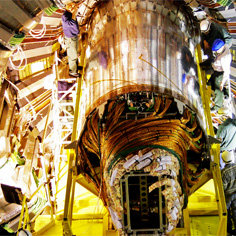Prof. Ferguson and the LHC Project

Thousands of physicists around the world are cautiously waiting for a decades-long project to unravel some of the mysteries of the universe. Among those excited at the prospect is Tom Ferguson, a Carnegie Mellon professor of physics for 24 years — and a 16-year-long member of the team at work on the groundbreaking project.
Ferguson and his colleagues are participants in the Large Hadron Collider (LHC) project organized by the European Organization for Nuclear Research (CERN). It is the world's largest, most complex and powerful particle accelerator, spanning 17 miles in circumference beneath the France/Switzerland border, just outside Geneva — what Ferguson terms, 'the biggest of big science.'
Scientists have been using increasingly higher-energy particle acceleration for more than 80 years in their effort to better understand our world at the sub-atomic, and now elementary, level. With the LHC, they're hoping to make history.
The Carnegie Mellon team has been working on one of the four massive LHC experiments, the Compact Muon Solenoid (CMS), developing complex electronics and software as part of the detector's particle detection system. The team currently includes four faculty members, four research scientists and three graduate students.
After years of development, the LHC began operating in September 2008, but a malfunction and consequent repairs derailed plans for yet another year. It was fired up again this past November, and initial lower-energy collisions were successfully made.
This year, researchers are cautiously hoping to produce collisions at the highest energy levels to date — 7 trillion electron volts (TeV) — and eventual collisions at an unprecedented 14 TeV, where many theorists predict that something 'new' will occur.
While much has been written about proving the existence of an elusive theoretical particle, the Higgs boson, Ferguson expresses the hopes of the physics community more broadly.
"If all we found was the Higgs, we would be bitterly disappointed because it's the last undiscovered particle in a theory we [still] don't understand," he explained. "We're trying to discover why nature made these particles and why they have the properties that they do. We know that nature is telling us something, but what?"
"In the last 20 years," Ferguson added, "there have literally been hundreds of theories predicting what we're going to find. Many of them are mutually exclusive, so we know that at least 99 percent of them are wrong. And most of us hope that all of them are wrong, because that's the ultimate dream of any experimentalist — to find something that no one's ever thought of."
Ferguson has lived a balancing act for years, alternating between teaching at Carnegie Mellon throughout the school year and spending research summers in Switzerland.
As cautiously excited as he remains for the discoveries of an actual lifetime, Ferguson is especially proud of being a member of such a diverse and expansive team.
"This is really the U.N. of science," he said simply, noting there are thousands of scientists and engineers at work on the project representing more than 80 countries. "We have Pakistanis working with Indians, Israelis working with Jordanians. For us to be able to cooperate and build something this complicated, I think, is a real testimony to humanity."
Photo: Installation of the world's largest silicon tracking detector in the CMS experiment
Related Links: CERN | LHC | CMS | Carnegie Mellon's CMS Page | Dept of Physics
Homepage Story Archives



